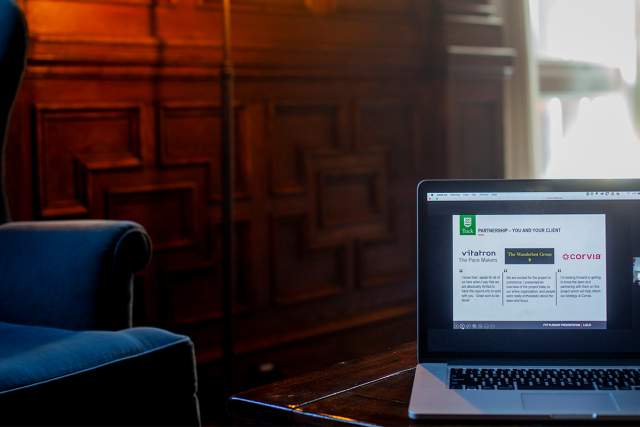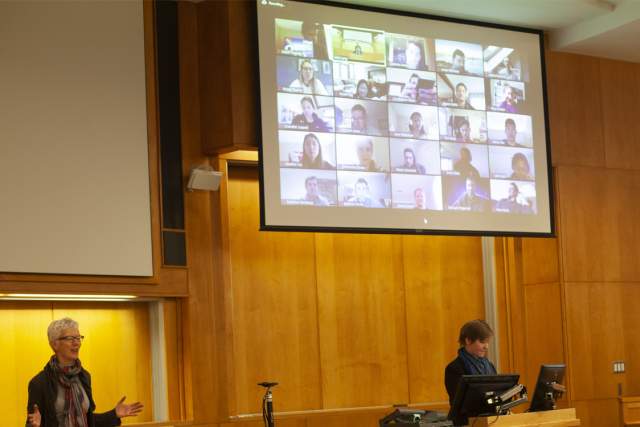Learning the principles of microeconomics, strategic communication, and analytics in the classroom is hard enough. Applying them to a real-world project of strategic and social significance is an entirely different proposition, especially when you have just nine weeks to do it.
Every year, first-year Tuck students take on this challenge through the First-Year Project (FYP), a core course in which teams of five students work directly with organizations ranging from nonprofits to major corporations to solve a mission-critical problem.
This year, in keeping with Tuck’s mission of educating wise leaders who better the world through business, several projects focused on environmental, social, and governance (ESG) initiatives.
“Teams always do great work on important topics for our clients, but I think the projects that are most impactful for both clients and students are those with an important societal question—a project or organization with an ESG imperative,” says FYP director Becky Rice-Mesec who has led the course for over 15 years. “It is working on these projects that an MBA team from a school like Tuck—applying current management concepts and rigorous research—can really make a difference.”
Here’s a closer look at three 2022 FYPs that moved the needle.
Client
Dream Corps
Challenge
Creating a program to disrupt the prison industry in Arkansas
The United States government spends approximately $85 billion each year on prisons and jails, yet half of the people released from prisons are reincarcerated within three years. To many academics, this represents an intractable challenge—but to Kakeru Tsubota T’23 and his FYP team, it also demonstrated a market failure.
Tsubota and his teammates, Addie Bodell, Elyse Curtis, Jordan Figueroa, and Margaux Richman, partnered with Dream Corps, a California-based nonprofit working toward criminal justice reform. Dream Corps had already identified on-the-ground supporters for new approaches in the state but needed a strategic framework to focus those efforts and create a sustainable program they could duplicate in other states.
The team, which had little background knowledge of the prison industry, spent the first two weeks fact-finding and talking to stakeholders. Working closely with Ruby Welch, an expert on the incarceration cycle in Arkansas, they defined what Tsubota calls the “customer journey” of newly released inmates.
“You have three steps to consider,” he says. “The first two days are critical. You don’t have cash, transportation, or housing. Unless you can find support within those two days, you are likely to end up back in prison. Then you have two weeks in which you need to find a job. You not only need a resume but also an explanation of your time in prison. Then you have the continuing process of parole and readjusting to life.”
While numerous programs address different aspects of the transition, Tsubota explains, it largely fell to individual advocates like Welch to connect inmates with a patchwork of resources. “Our challenge was to provide wraparound services that are not dependent on a single person,” he says.
After a visit to Arkansas to see the problem firsthand, the team arrived at a structured peer support model, in which formerly incarcerated mentors would be trained and paid to work with newly released inmates to provide logistical and personal support.
As a final deliverable, the team developed a pitch deck outlining the specifics of a program that Dream Corps could implement and scale. They designed a minimum viable product, a 36-month ramp-up plan, identified KPIs, and suggested possible funding sources, including government grants and corporate sponsors. Dream Corps, Tsubota reports, is exploring the next steps needed to bring the program to life. The project will also live on at Tuck, where Clinical Professor Hanne Pico Larsen is writing a case based on the work.
Client
Vestas
Challenge
Refining wind turbine manufacturing processes
All Tuck students study the ins and outs of manufacturing—but due to the complexity of those processes, pure operations challenges that fit within the timescale of an FYP are uncommon. For Cara LoPiano T’23, whose professional background is in sales in the solar industry, and Jon Martell T’23, a former ExxonMobil engineer, that challenge was a draw.
With a shared interest in working in a new-to-them energy space, the two students collaborated with April Salas, the executive director of Tuck’s Revers Center for Energy, Sustainability, and Innovation and interim executive director of the Arthur L. Irving Institute for Energy and Society at Dartmouth, to source an FYP project leveraging the Dartmouth network. They landed on a collaboration with Vestas, a major player in the global wind industry, whom the Revers Center had previously cultivated a relationship with.
“Centers at Tuck play a strong role in connecting the classroom to industry, and providing unique opportunities for Tuck MBA students to engage in real-world, practical projects with innovative companies,” says Salas. “I am proud that our students were able to work with Vestas and provide a fresh set of eyes and new ideas for how to optimize operations.”
LoPiano and Martell filled out their project team with Kate Bayeux T’23, Karl Mortensen T’23, and Rahul Jaisingh T’23, each of whom brought experience in various aspects of the energy industry. All five are also Revers Center Fellows.
There’s nothing like being able to walk on the factory floor. … That was instrumental in being able to make good quality recommendations to the client.
—Cara LoPiano T’23
Tasked with improving processes at Vestas’ manufacturing plants, the team traveled to Colorado to tour a facility.
“There’s nothing like being able to walk on the factory floor,” LoPiano says. “Senior Associate Dean Joe Hall said that to us when we asked for advice on how to approach the project, and he was absolutely right. We could see some of the things that we could think about optimizing and adjusting and get a sense of whether those ideas were actually feasible. That was instrumental in being able to make good quality recommendations to the client.”
Though the ins and outs of manufacturing were new to the students—LoPiano joked that Operations Management was a “just-in-time course” that provided critical frameworks—they quickly rose to the challenge.
“Our deliverable was a set of recommendations for process adjustments,” she explains. “These are very complicated systems, but we made a few small suggestions that would allow them to pick up a few minutes here and there and make the process run a little smoother. A lot of what we came back with was things they had considered changing, and we gave them another voice and angle on how to do that.”
Client
South Pole
Challenge
Sizing the market for technical carbon dioxide removals in 2030
While avoiding and reducing emissions is key to fighting climate change, it is not enough to meet global climate targets set by the Paris Agreement. That’s where technical carbon removals—technologies that capture carbon dioxide from the atmosphere—come in. However, no readily-available research had projected future demand and supply for these emerging solutions, at least until Geet Kalra T’23 and his FYP teammates came onto the scene.
Kalra, who brings a background in sustainable investing to Tuck, self-sourced a project through a Tuck alum at South Pole, an international carbon finance consultancy and project developer headquartered in Zurich. The challenge? To predict what the market for technical carbon removals would be in 2030, data that could be used to drive investment.
Kalra, who admits he lacked technical expertise in energy or carbon removals, was nevertheless “bullish on the market” and saw the FYP project as a chance to delve into a new problem space. He and his teammates embarked on several weeks of intensive reading and studying to understand the technology and background before crunching the numbers. “It took time before we were able to pull the pieces together to build a narrative,” Kalra says.
We were all surprised by where an FYP can take you. It took us to sitting next to CEOs of Fortune 500 companies, having drinks with them, and answering their questions.
— Geet Kalra T’23
Despite the technical material and tight timeframe, the team successfully delivered a Tuck-authored first-of-its-kind report that South Pole used in its outreach to investors and the media. The objective was to make Tuck one of the thought leaders in this nascent but rapidly growing space, says Kalra. But the journey didn’t stop there. South Pole invited the team to present their findings at the sidelines of the World Economic Forum annual meeting (WEF22) in Davos, Switzerland, where the company launched its NextGen CDR Facility.
“Technical carbon removals themselves were a huge topic of discussion during WEF22—many public and private sector leaders, including Bill Gates and special presidential envoy John Kerry talked about it,” says Kalra. “This report came out a few days before WEF22, so it was a hot topic.” The team shared their findings with a significant audience, including the CEOs of several major corporations and numerous public officials. As invited guests, they also enjoyed the once-in-a-lifetime chance to attend other WEF presentations and events.
“We were all surprised by where an FYP can take you,” Kalra laughs. “It took us to sitting next to CEOs of Fortune 500 companies, having drinks with them, and answering their questions.”
The Tuck Environmental, Social, and Governance (ESG) Fund is a student-run investment fund that invests in for-profit enterprises that exemplify ESG objectives through their mission, practices and purpose, while maintaining a strong financial return. The fund is also aimed at facilitating experiential learning opportunities for the next generation of leaders in ESG investing.

